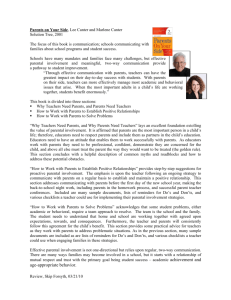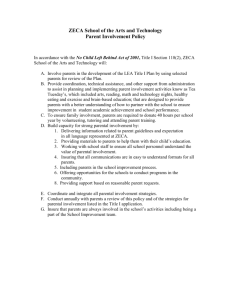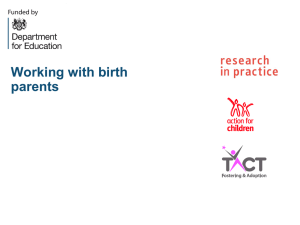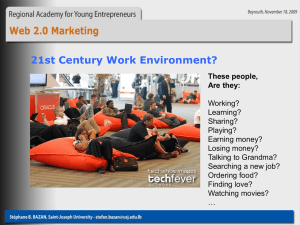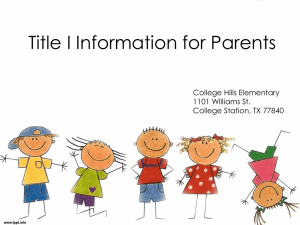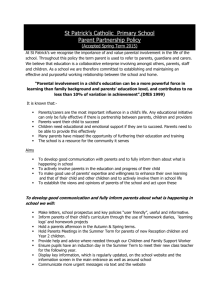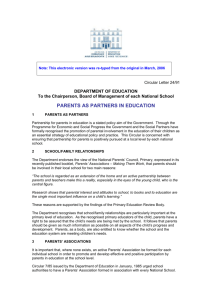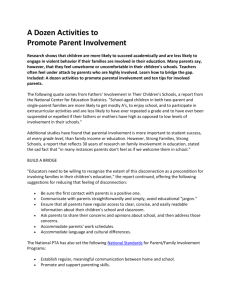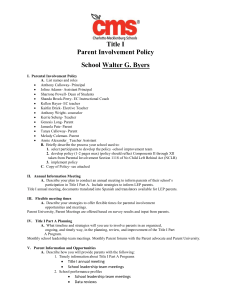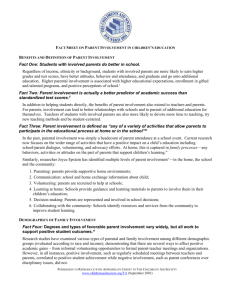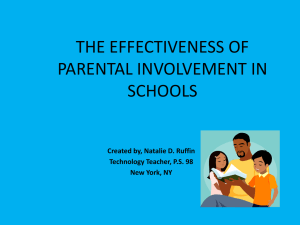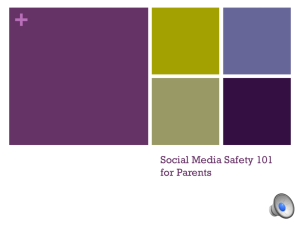Creating Real Parent Engagement in Our Schools
advertisement
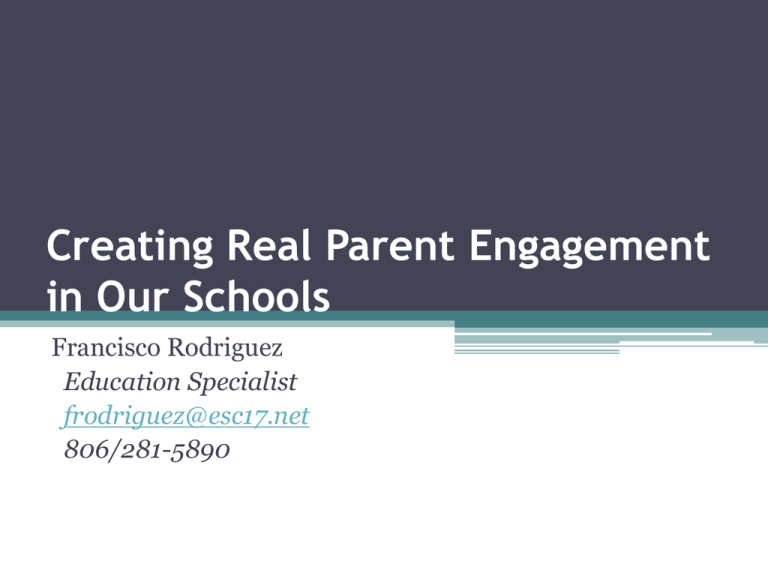
Creating Real Parent Engagement in Our Schools Francisco Rodriguez Education Specialist frodriguez@esc17.net 806/281-5890 Barriers to Parental Involvement • The most recent research on effective parental involvement shows that numerous barriers to involvement exist for both schools and families. Some barriers are created by limited resources, while others originate from the beliefs, perceptions and attitudes of families and school staff. (Liontos, 2012) The most common barriers to family involvement include: • Lack of teacher time. • Educator’s misperceptions of parents’ abilities. • Lack of understanding of parents’ communication styles. • Family mobility, limited family resources, such as transportation and child care. • Parents’ lack of comfort and vested interest in the school along with tension in relationships between parents and teachers. • Difficulties of involvement in the upper grades. (Jones, 2001; Baker, 2000; Caplan, 2000; American Association of School Administrators, 1998; Liontos 1992) Additionally, family involvement programs are often not fully implemented because: • School staff had not been trained to work with families. • Administrators and teachers worried that increased family involvement would add to their already busy schedules. • Educators were concerned that closer relationships with families would mean giving up power and decision-making. • Families were not sure how far they could go in making suggestions or asking questions; they worried that children would be punished for their parents’ actions by a teacher or principal who was annoyed or threatened by the parent. “We follow the law…” • Based on research and survey results: ▫ Current parent involvement provisions of the law are solid and ambitious ▫ Parent involvement has fallen to the bottom of the list of NCLB requirements, though it is integral to the success of the law and of students and schools. ▫ Data reports are distributed, but they are often confusing and overwhelming. Effective strategies to increase parental involvement • Welcome families into the school. ▫ Foster a climate of mutual respect and trust. • Tailor programs and correspondence to schools’ specific needs and be respectful of diversity • Engage in two-way, regular communication with families. (Blazer & Drake 2000) Research clearly identifies certain types of parental involvement and specific strategies as effective in supporting student learning. • Increasing the number of contacts between the school and the parent does stimulate parental engagement. • Studies find that increased school-initiated contact resulted in reciprocal parent contacts. ▫ Thus, enhanced school contacts with parents should increase the parents’ contacts with school. • Creating opportunities to engage parents to a greater degree in school can increase their involvement in the school’s organization structure. Communicating • An example goal: design more effective forms of school-to-home and home-to-school communications with all families each year about school programs and their children’s progress. Communication for Parents in the 21st Century… • Parents WANT to be informed!!! Parents want INSTANT updates, news, and information about their children's schools. • Parents are BUSY!!! • Technology just might make your job EASIER!!! Tips to communicating with Millennial (or Gen Y) parents… • • • • • Set clear expectations Be sensitive to parents’ views Be proactive Use examples and evidence Separate the student from the behavior • Don’t promise what you can’t deliver • Take time to answer questions Websites • Don’t forget to update the calendar regularly to drive parents and students back to your website for the latest news and information. • Access to a list of teacher, administration and faculty email addresses is essential for open parent communication and relationship-building. The more engaged parents are, the more connected students will likely feel to their school and community. • Explore interactive tools that drive parents and students to your site frequently, improve operational efficiencies, and foster community involvement and student, parent and teacher interaction. E-Mails • Quick and easy • Easy for a parent to respond • Allows families to know about free local events ▫ “Green” newsletters • Documentation is made easy and electronic Google Calendar • Very easy to update • Many privacy options • Easy customizable • Can be added to wiki, blog or webpages District/Campus/Classroom Blog • Works like an online journal • Easy to add to and update • Students/parents can leave comments • Post links, videos, pictures… Online Surveys • Keep apprised of parent opinions • Find out the best time to organize events • Gather cultural information from your families to plan classroom celebrations Twitter…Tweet Parents! • Very quick, easy updating • Add Twitter “widget” application to website, wiki or blog • Families can view tweets on their mobile devices Facebook! • Many parents are already on Facebook, so it makes sense to communicate with them on a platform with which they are already familiar. • Facebook allows you to share class news and information with the parents of your students. • Parents who might be uncomfortable asking questions in person might feel more at home when using this medium.



